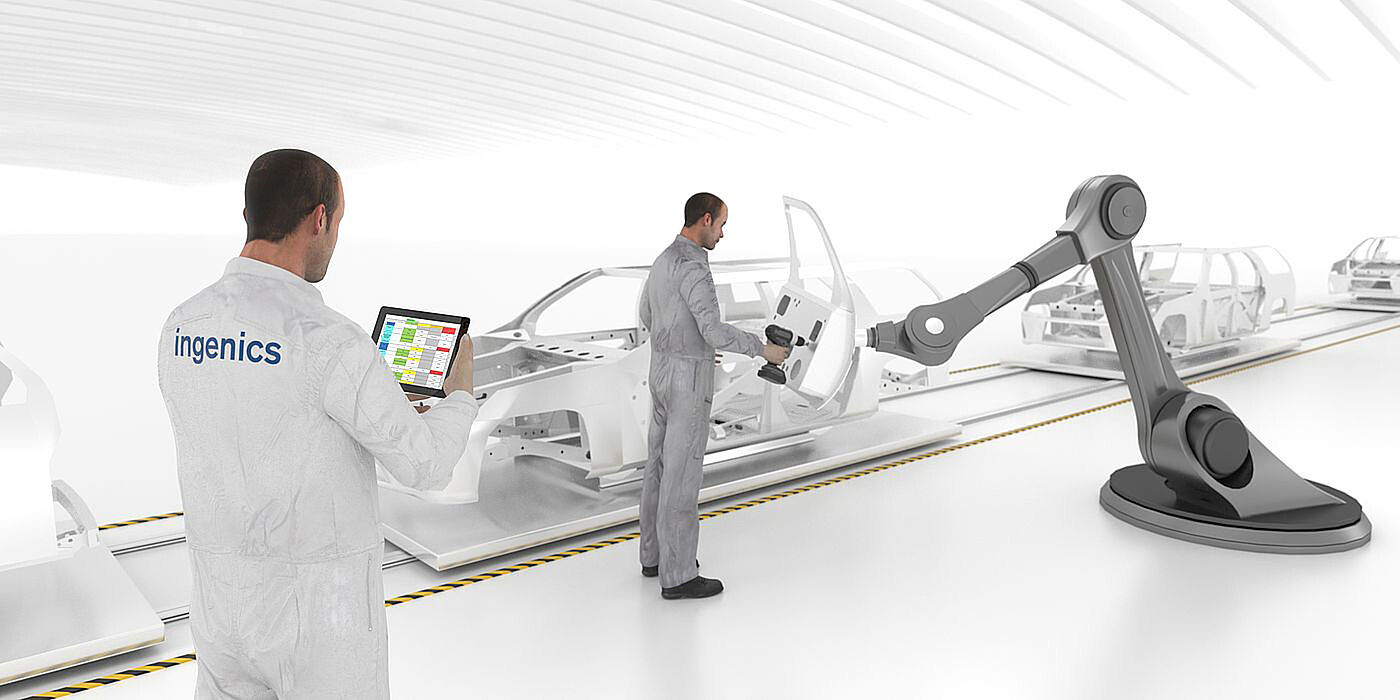Solutions for a new level of quality in human-robot collaboration at Audi
 ©
©
Optimizing assembly in the context of industry 4.0
The optimized use of robotic systems is set to play an increasingly important role with respect to Industry 4.0. In order to achieve maximum efficiency in assembly, robots and people will have to work together much more closely than was and is the case in traditional factories. In Ingolstadt, Audi and Ingenics are working intensively to create new solutions in human-robot collaboration (HRC).
The strong influence of Industry 4.0 means that developments in production need to enable the use of robots in close cooperation with people without elaborate protective equipment so that each side can complement the other safely and in the best possible manner. Ingenics is currently working with AUDI AG to identify and analyze possible pilot applications in final vehicle assembly.
Until now there had been a strict separation between jobs performed by people and robots for safety reasons. Work areas were normally separated by security fences, preventing human-robot collaboration from turning into humanrobot collision. However, this also caused companies to miss out on exploiting major sources of potential for efficient and smooth production. People in many places are now looking at human-robot collaboration in a new light. “There will have to be an extensive reorganization of HRC,” says Thomas Kleinbeck, project manager at Ingenics.
People in a digital environment
Wherever humans and robots “get in each other’s way” these days, the machine will typically stop as soon as a potentially hazardous situation is detected. As a result, production may slow down or come to a complete standstill for a time. “This is something we should no longer tolerate,” explains Kleinbeck. “We urgently need new safety concepts that allow for close cooperation without slowing down operations in production.” He goes on to say that such systems must register activities in progress and accurately assess risk potential based on the overall context and current situation. “Standardization of context-dependent safety systems and their integration into intelligent production environments are fundamental requirements if robots are to be used effiectively and economically in mixed work environments.”
Reliable safety and protection systems are still indispensable whenever work areas of people and machines overlap. “We have no intention of shaking things up on that front, of course,” says Kleinbeck. “In order to make production as effcient as possible and to strike the perfect balance between the advantages of human and robot performance, we are striving to ensure that robots are not taken out of service at any time or too narrowly limited in their activities.” Thanks to smart integration of sensors, software, and lightweight robots, the entire system can calculate each risk and take protective action, from evasive maneuvers and speed adjustments to altered movement sequences.
Selection and implementation
It is not enough to simply come up with concepts for so-called cyber-physical work environments – these also have to be implemented and proven to be fi t for their purpose in practice. Ingenics therefore created a comprehensive list of criteria to enable systematic identifi cation, analysis, and evaluation of HRC applications. Comparing this list of criteria to an assembly facility enables identifi cation and classification of potentially realistic scenarios from a pool of possible fields of application.
The first step was to evaluate an assembly line at the Audi plant in Ingolstadt using the newly developed tool from Ingenics. A large number of suitable applications were then ranked. The most suitable of these were examined in greater detail and presented to responsible parties at Audi. The decision was made a short time ago to implement several of these applications in pilot projects based on an overarching roadmap.
There is no doubt that Ingenics has the expertise and experience in assembly planning and implementation that is necessary to evaluate HRC applications. In addition to specific knowledge of the properties of HRC robots and a systematic approach to analysis and evaluation, the consulting firm offers everything it takes to ensure that fast, clear identification of potential HRC applications and their implementation are realistic goals.
“Audi would like to implement applications in a timely manner,” explains Tobias Katai, a key account manager at Ingenics. “The roadmap we created will ensure that nothing gets in the way of rapid implementation.” Dr. Veit Rückel, a specialist project manager for HRC systems at Audi, notes: “Working with Ingenics was very constructive and productive thanks to the consultants’ detailed technical knowledge. This helped to make sure that AUDI AG can retain its ‘Vorsprung durch Technik’ when it comes to HRC applications – a concept that matters a great deal to the management.”
Profitability checklist devised for human-robot collaboration in assembly
Ingenics annual theme is “From vision to reality – intelligent solutions for the digital transformation of assembly, production, and logistics with Industry 4.0.” Driven by this focus, the group is developing its expertise in Industry 4.0. Currently, intensive work is in progress on new, innovative solutions in the cutting-edge field of human-robot collaboration (HRC). Ingenics has developed its own checklist to systematically examine whether the use of collaborative robots in assembly is really worthwhile for individual clients.

